THROUGH THE EYES OF THE WISE OLD OWL.
A wise old owl sat in an oak; The more
he heard, the less he spoke; The less he spoke, the more he heard; Why aren't
we all like that wise old bird?
In European culture the owl has always
been venerated as the keeper of wisdom and this tradition is traceable back
to Athena, who, in Greek mythology, was the virgin goddess of arts, crafts,
sciences and war strategy. The very wise Athena was represented as having
large owl-like eyes and she wore a helmet bearing an owl symbol. The owl was
a protected bird in ancient Greece and large numbers of them occupied the
Acropolis. Two "capacity marked" earthenware vessels were found
at the bottom of a well at the Acropolis. Of these, one was marked as a public
standard Khous (194.4 cubic inches) and bore the official "owl"
stamp of Athens, attesting to the integrity of its measure. The second item
was an official water clock, marked as two Khous. In Greek mythology owls
were the messengers of Hecate, goddess of witches and sacred to Persephone,
goddess of prophecy.
According to the Welsh Mabinogi, the May
Queen, Blodeuwedd, had formerly been human, but had been turned into an owl.
In ancient New Zealand culture the owl, or Ruru, was the guardian of knowledge
and a person nearing death would hear the owl call out his or her name when
it was time to die. The same near death tradition is harbored by North American
Indian tribes.
We will now proceed with introducing more
"owl eyes" circle geometry into the Clandon Barrow Lozenge, but,
in an act of mercy on the reader, will dispense with lengthy explanations
related to the scientific meaning behind each circle code...only identify
the likeliest coded value occurring at each station point. All circles shown
have been precisely sized in AutoCAD, in British Standard inches, to the coded
values listed.
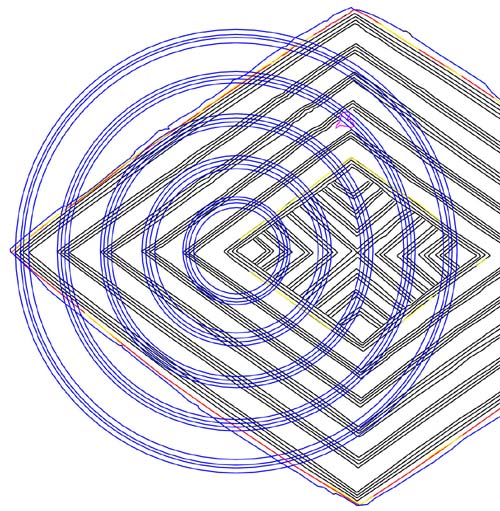
Circle geometry occurring on the left side of the lozenge.
Here are the abbreviated codes in inch radii:
- 1.944 (navigation), 1.9 (calendar), 1.875 (compass, navigation), 1.8265
(solar year).
- 1.575 (lunar, reed navigation), 1.542857143 (7ths divisions of 360, navigation),
1.512 (Great Pyramid, navigation, etc.).
- 1.2 ("6" series navigation), 1.166666 (navigation), 1.134 (lunar,
Stonehenge), 1.1 ("11" series navigation.
- .833333 (3,4,5 triangulation), .8 (navigation, compass), .768 (navigation),
.72 ("6" series compass, navigation).
- .4725 (lunar), .45 (compass), .42 ("6&7" series navigation),
.378 (Great Pyramid, navigation, etc.).
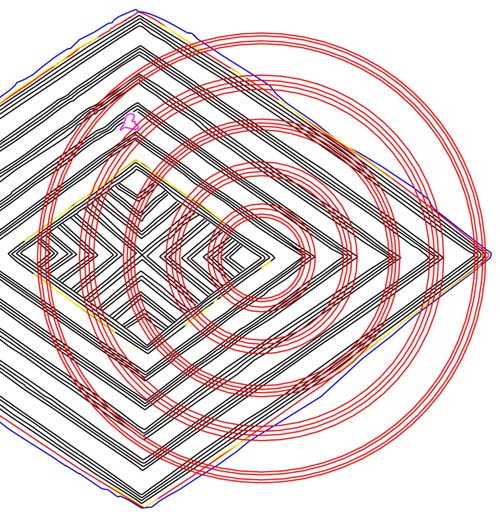
Researchers are encouraged to study these pictures and observe
the precision with which the circle geometry relates, specifically, to the
exterior edges of the Clandon Barrow Lozenge, as well as inner points and
lozenge edges. Each circle shown in the above picture has been sized in AutoCAD
to the following inch radii:
- 1.96875 (lunar), 1.944 (navigation), 1.9 (calendar), 1.875 (compass, navigation).
- 1.6 (compass), 1.5552 (navigation), 1.51875 (lunar), 1.4765625 (lunar).
- 1.215 (lunar), 1.18125 (lunar), 1.152 (navigation, lunar, Menkaure Pyramid),
1.125 (compass, navigation).
- .84 (navigation, "6&7" series), .792 (navigation, "11"
series), .756 (Great Pyramid, navigation, etc.), .72 (navigation, etc).
- .4725 (lunar, Khafre Pyramid), .432 (navigation), .384 (navigation, etc.),
.3564 (navigation, Menkaure Pyramid).
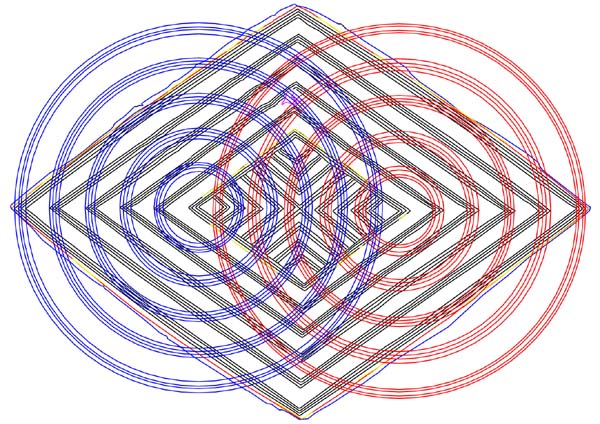
The old owl awakened anew...While the owl slept its reputation
was much maligned and its profound wisdom brought into question and dispute...
The old sage is now wide eyed, alert, hungry and ready to wreak havoc amongst
the scurrying, vermin.
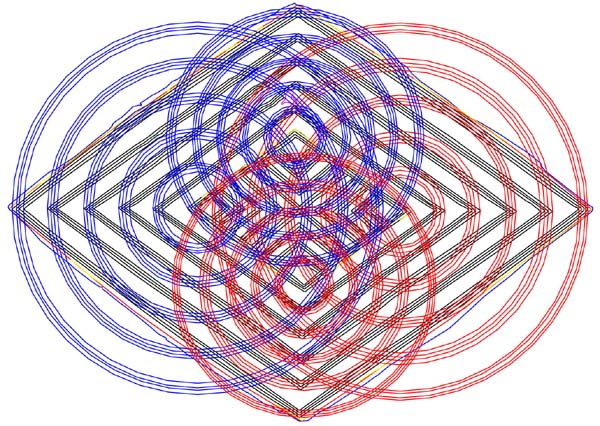
The result of combining all of the circle geometry identified
and restored thus far. There are yet many more stations and fulcrum positions
from which coded circles expand and it is not within the scope of this article
to identify them all. Suffice it to say the artisan (s) who fabricated the
Clandon and Bush Barrow memory devices was a very adept scientist, in possession
of profound knowledge that was already steeped in age long before the lozenges
were made. That selfsame knowledge is of unknown origin. It is still readily
extractable from ancient structures on many continents by using a measurement
increment that has come to be known as the British Standard
inch. The profound, age-old knowledge seems to have been carried to
France and Britain from former homelands around the Eastern base of the Mediterranean.
One of the first acts of those emigrating to Europe from the Near East was
to build the great stone library of codes at Carnac (Le Ménec), where
1100 menhirs were placed in rows, with end circles. The "out of Egypt"
codes are preserved there to this very day in the positions of each menhir,
as viewed from resolving, hubstone positions at each end of the "knee"
or hubstones within the end circles.
The scientific principles encoded into these lozenges was once
shared and held sacred by the great civilisations of the Mediterranean and
Europe. Devices such as this were carried in an ephod vest by Israelite priests,
who called them "Urim & Thummin" (light and perfection). For
several thousand years the expansive parcel of special knowledge was carefully
preserved and handed on intact to each ensuing generation. It was, most certainly,
alive and well in Britain by the time the ever persistent Roman armies finally
gained a foothold there, after 100 years of trying. Once the Romans had, somewhat,
consolidated their power base the infrastructure of Britain was assailed and
the Druidic priests slaughtered at Anglesey. With the decline and fall of
Rome, centuries later, came the rise of the Roman church. Under Augustine
(circa 587-604 AD), England was proslyted and, once the church had influence
over the monarchs and had consolidated its power, an assault on the already
much decimated Pagan sciences began afresh.
"Gregory, prompted by divine inspiration,
sent a servant of God named Augustine and several more God-fearing monks with
him to preach the word of God to the English race. In obedience to the pope's
commands, they undertook this task" (Bede).
Under Pope Gregory, Catholic churches were built on top of numerous
standing stone circle sites to smother and eradicate the deep science that
reposed within the measurable, coded positions of the stone components. Secret
organisations and ancient guild networks did all that they could to preserve
what was left of the fragmented knowledge. Sadly, an age of great enlightenment
was systematically supplanted by one of superstition, cruelty, exploitation
and pig ignorance...the legacy of which persists to this day in the way our
entire western society functions and conducts its business. Our age-old inheritance
was stolen off us by power mongers using trickery, treachery, lies, deception
and force. What was once deep astronomical/ navigational science, used for
the betterment and optimisation of all society, was slandered into the realm
of "devil worship" by the conniving, self aggrandizing and brutal,
church patriarchy.
CHANGING DIRECTION.
As an example of just how much knowledge is left to extract
from the Clandon Barrow Lozenge, let's analyse the codes that repose within
the innermost diamond:
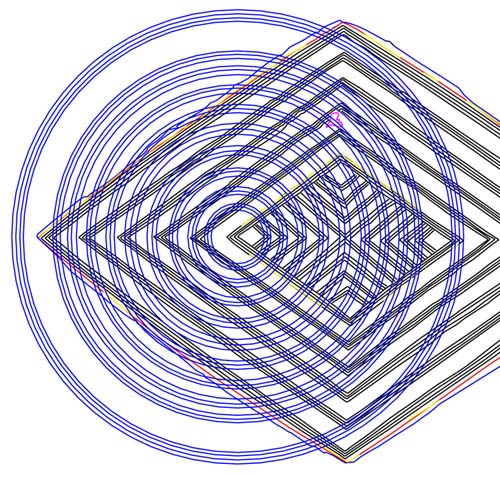
Instead of sending the circles to outer points, this time
they are sent to subsequent inward points through the central diamond. Here
are the apparent codes. Each circle shown complies to the inch radii values
listed:
- .264 ("11" series navigation), .3 ("6" series progression),
.33 ("11" series navigation).
- .42 ("6&7" series navigation), .4536 (Great Pyramid, navigation,
lunar), .495 ("11" series navigation).
- .6 ("6" series progression), .648 (Precession of the Equinoxes),
.6804 (lunar nutation cycle).
- .81 (PHI & rounded PHI), .8505 (lunar nutation cycle), .9 ("6"
progression).
- 1.0125 (lunar), 1.066666 (conversion ratio, 15/16), 1.12 (navigation).
- 1.265625 (lunar), 1.3068 (equatorial circumference), 1.4175 (lunar, Khafre
Pyramid).
- 1.5 ("6" series progression), 1.6 ("8" series progression),
1.65 ("11" series progression).
- 1.6875 (lunar), 1.76 ("11" series navigation), 1.8 (compass, "6"
series progression).
- 1.83333 ("11" series navigation), 2.12625 (Sabbatical calendar,
lunar), 2.16 (lunar, Precession, diameter of the moon).
- 2.2 ("11" series navigation), 2.24 ("6&7" series
navigation).
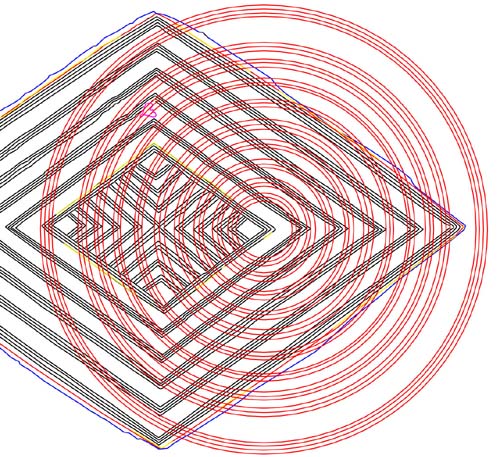
Again, these circle swirl inward across the station points
of the inner diamond. Listed below are the precise sizes of the circles shown,
in inch radii, all of which were very important numbers from the ancient parcel
of coded values:
- .2835 (lunar, Khafre Pyramid), .324 (PHI & rounded PHI, Megalithic Yard),
.364 (calendar year raw count).
- .46875 (compass, navigation, lunar), .432 (Great Pyramid, navigation), .5184
( Great Pyramid, navigation).
- .618034 (volume vessel formula, PHI fraction), .6534 (equatorial circumference),
.704 ("11" series navigation).
- .816666 (calendar), .8533333 (navigation, lunar calculations), .9 ("6"
series).
- 1 (inch reference), 1.05 (Hebrew reed), 1.1 ("11" series navigation).
- 1.215 (lunar), 1.265625 (lunar year 28 mansions), 1.3 (lunisolar calendar).
- 1.44 (navigation), 1.466666 ("11" series navigation), 1.512 (Great
Pyramid, navigation).
- 1.62 (PHI & rounded PHI), 1.66666 (3,4,5 triangulation), 1.701 (lunar
nutation cycle).
- 1.782 (Menkaure Pyramid, "Y" Holes, navigation), 1.82625 (solar
year), 1.866666 (solar calendar).
- 2.12625 (Sabbatical calendar lunar count), 2.16 (Precession, diameter of
moon), 2.2 ("11" series navigation).
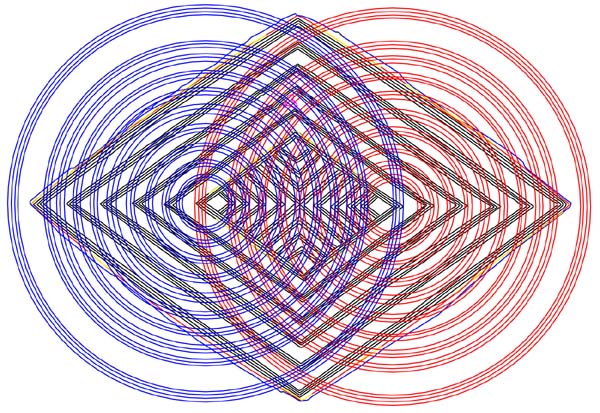
The dual sets of coded circles extending inward through the
length of the inner diamond. The code extraction process could be extended
further through the 5 sets of lozenge stations further out...to the outer
extremity points. This will give the reader some appreciation of the amount
of dormant scientific information yet to be identified.
SOME INTERIM CONCLUSIONS.
The stumbling block for archaeologists and historians analysing
artefacts, such as the Clandon Barrow and Bush Barrow lozenges, lies in the
ingrained belief that ancient cultures were not particularly advanced in their
sciences. The prevailing conclusion of our academics is that there was no
universally shared measurement standard and that lengths used in building
work were, for the most part, roughly "paced out", or determined
by the distance from the "elbow to the tips of the fingers", etc.
Our historians hold to the view that it was commonly believed, in antiquity,
the Earth was flat and, certainly, there was no science available to determine
just how big it truly was, at least not until the time of Eratosthenes. Our
historians tell us that the oceans were great barriers, which isolated continents
and civilisations from each other, forcing cultures to develop separately,
with little or no hope of contact or the sharing of scientific and cultural
ideas. Even the puny little strip of water known as the English Channel represented
a reasonably significant barrier to Mediterranean influences reaching Britain
easily... we're told.
The very ancient Sumerian/ Babylonian degree angle system of
360-degrees in a circle, breaking down sexagesimally into minutes and seconds
of arc, or their chronology system of 24 hours in a day, breaking down sexagesimally
into minutes and seconds of time, have been used in Britain since very ancient
times. Despite this we're led to believe that the people of Britain didn't
inherit the Sumerian/ Babylonian measurement standard. A measurement standard
of length must always precede the more difficult metrology sciences related
to degree angle or chronology systems.
Precise assessments of lengths, angles, volumes and proportions
within ancient Mediterranean and European structures or artefacts shows us,
definitively, that there was a shared "inch" common to all of the
ancient civilisations of the European / Mediterranean region. The existence
of that "inch" becomes indisputable when one analyses the 3-dimensional
volumes within ancient liquid or dry measure vessels of the Mediterranean.
The selfsame inch, which became known as the British Standard inch, was certainly
used in the fabrication of the Clandon Barrow and Bush Barrow lozenges. All
of the official "standards" for length, volume, area or weight,
used within the ancient Mediterranean, are a part of the same mathematical
family. All are based upon the selfsame inch. The standards of length, volume,
area or "grain" weight, used by the great civilisations of the region,
were all in a perfect ratio to each other. If our scientists could surmount
just one mental obstacle, related to the existence of the commonly shared
"inch", then profound science, reposing in the great stone sites
across Europe, or the massive edifices of the Mediterranean, Near East &
Middle East, could be decoded and their in-built principles restored to world
knowledge.
See: Weights,
Measures , Volumes:
CONTINUE






